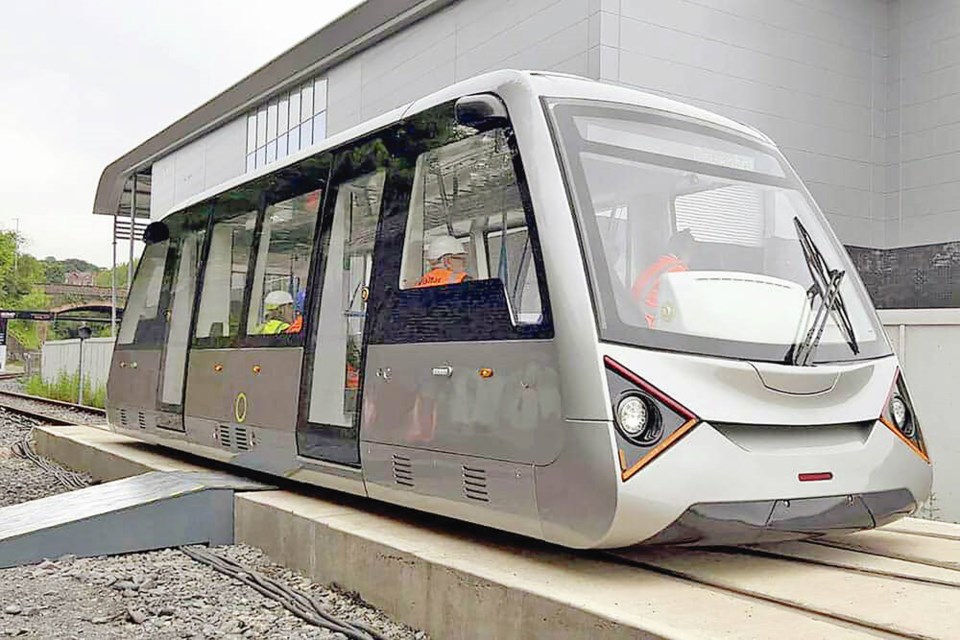View Royal Mayor Sid Tobias is asking other local governments to get behind the town in finding a suitable site to test light-rail transit tracks and technology.
Council has agreed to explore a pilot program that would allow a Canada-U.K.-based partnership to lay two to three kilometres of tracks along an existing road or trail to support a light-rail battery-powered train similar to a system under development in Coventry, England.
Tobias said the route could be in View Royal or connected to trails or roads in Langford and Colwood. The Galloping Goose Trail would be ideal if it could be widened. The Island Highway through View Royal and Colwood — either at the centre line or on one side — has also been suggested by the line’s proponents.
In a presentation to council this week, Stephen Kong of Vancouver-based Thinkeco Power Systems Inc. and officials from Penmark, an English consulting firm involved in the Coventry Very Light Rail project, said the system would use lighter-gauge tracks and concrete slabs that can be installed at a quarter of the cost of conventional rails.
Trains would be battery-operated, bi-directional, and subject to less friction and wear.
Kong said the track system uses patented concrete slabs that can be laid at depths of less than 30 centimetres, avoiding the need to uproot utility systems, and can be laid in weeks at a cost of about $20 million per kilometre.
Vic Young of Penmark said new ultra-light trains can be recharged in 10 minutes, reach speeds up to 90 kilometres per hour and seat up to 56 passengers.
Tobias said although the system would be ideal for the E&N rail corridor, the Esquimalt to Victoria line isn’t being considered for a pilot test site, as negotiations over the E&N lands continue with First Nations.
Tobias said it makes sense for View Royal, a nexus for transportation between the core, the West Shore and up Island, to take a leadership role in “encouraging innovation of emerging transportation technologies that respect the environment and the land to facilitate our growing regional population.”
Similar presentations are expected to be delivered to Colwood and Langford councils in the coming weeks. Tobias has written letters to all councils, including the CRD, as well as provincial and federal officials to open discussions on the pilot project.
Tobias said the region needs alternatives to the Colwood Crawl, one that complements the work of rapid bus lines and lanes.
“Growth does not just mean more housing,” said Tobias “If we do not evolve our infrastructure we will fail at building for a future.”
Kong did not disclose the cost of the test stretch of rail, but said it will be built at no direct cost to municipalities.
“We have the backing of Canada Infrastructure Bank and their interest is to promote any technology that would have zero emissions and this qualifies,” said Kong, adding a senior director has agreed to fund a six-month feasibility study to a certain limit. No financial details were disclosed.
That would encompass the work that Penmark will do with the train and tracks and the public engagement process that Kong will undertake, including presentation centres.
Young said Penmark is interested in the technology, not in the operation. A two- to three-kilometre test stretch is needed to bring trains to maximum speeds and a full stop.
“[Penmark’s] participation is at the beginning of the life cycle to enable local companies to get involved and to transfer existing global technology only,” said Young. “The long term would not include our business. The history of our business is that we’re on the forefront of innovation in the rail sector through research and redevelopment, enable local companies to get involved and then hand over.”
Kong said he could save the CRD money in widening trails along the test route; once testing is complete, rails can be removed and the region would be left with a “very durable sidewalk.”
Construction of a test site would involve using local workers and companies, said Kong.
“I’d like to see … people being able to jump on a train from Langford going all the way downtown,” said Kong.
Kong also wants to set up a training, and research and development centre to train electric mobility engineers on the West Shore.
“We are looking at a public-private partnership,” said Kong, “and we are getting investors who are very interested in green bonds and coming in to shoulder some of this burden so it won’t be so heavy for the municipalities to take on.”
CRD chair Colin Plant said he welcomes discussion of a testing site for light rail. But he cautioned any use of the Galloping Goose Trail will have to be closely examined.
“If it is used we would have to consider disruptions to trail users and the potential impact on the environment,” said Plant.
“It is important to note that the CRD is made up of 13 municipalities and we do want innovative ideas, so we will look at how the plan fits into our overall policy framework.”
>>> To comment on this article, write a letter to the editor: [email protected]



